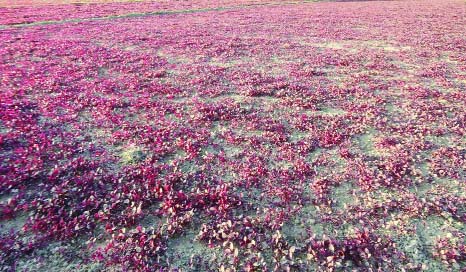
M A Awal, Narsingdi :
Lal Shak ( Red Celery) cultivation is gaining ground in the Narsingdi distict.
Lal Shak on abandoned lands and on the premises of their houses many farmers are used to cultivate Lal Shak on commercial basis.
According to Agriculture Extension Department [AED]. 80 hectares have been brought under Lal Shak cultivation in Narsingdi district. Many farmers have changed their lots by growing Lal Shak, the new nation correspondent visited different areas of shibpur, Belabo, Raipura, palash, Narsingdi sadar and Monohardi Upazila recently and saw farmers are working in their Lal Shak fields with much enthusiasm .
According to Lal Shak farmers, four to five thousand taka is needed to cultivate Lal Shak on one bigha of land, sowing of Lal Shak needs begins at the end of Bangla month of Ashar, but the full season begins from Kartik. At the beginning of the season, Lal Shak is sold at exorbitant prices.
Gradually the prices come down with adequate supply.
Haron-or-Rashid of Bharoter Kandi village of Shibpur Upazila said, five to six mounds of Lal Shak might be plunked from a bigha of land in a week.
During the whole season, Lal Shak may be plucked 5 to 7 times from land. Most of the farmers termed Lal Shak as a profitable vegetable. Excessive raid and flood are the main emenies of the vegetables.
Hormoja Baguam wife of Haris Miah, a farmer of Bharoter Kaindi village in Shibpur upazila said, “I have planted beans expending Tk 10,000 on one bigha of land and I am expecting to earn at least Tk 30,000 by selling the produce.”
Measures should be taken to combat the virus disease, which causes substantial damage to this cash vegetable, some farmers said.
Lal Shak ( Red Celery) cultivation is gaining ground in the Narsingdi distict.
Lal Shak on abandoned lands and on the premises of their houses many farmers are used to cultivate Lal Shak on commercial basis.
According to Agriculture Extension Department [AED]. 80 hectares have been brought under Lal Shak cultivation in Narsingdi district. Many farmers have changed their lots by growing Lal Shak, the new nation correspondent visited different areas of shibpur, Belabo, Raipura, palash, Narsingdi sadar and Monohardi Upazila recently and saw farmers are working in their Lal Shak fields with much enthusiasm .
According to Lal Shak farmers, four to five thousand taka is needed to cultivate Lal Shak on one bigha of land, sowing of Lal Shak needs begins at the end of Bangla month of Ashar, but the full season begins from Kartik. At the beginning of the season, Lal Shak is sold at exorbitant prices.
Gradually the prices come down with adequate supply.
Haron-or-Rashid of Bharoter Kandi village of Shibpur Upazila said, five to six mounds of Lal Shak might be plunked from a bigha of land in a week.
During the whole season, Lal Shak may be plucked 5 to 7 times from land. Most of the farmers termed Lal Shak as a profitable vegetable. Excessive raid and flood are the main emenies of the vegetables.
Hormoja Baguam wife of Haris Miah, a farmer of Bharoter Kaindi village in Shibpur upazila said, “I have planted beans expending Tk 10,000 on one bigha of land and I am expecting to earn at least Tk 30,000 by selling the produce.”
Measures should be taken to combat the virus disease, which causes substantial damage to this cash vegetable, some farmers said.

